Review: THE LAST FIVE YEARS at Desert Theatreworks is terrific.
This unique musical runs through May 21st.
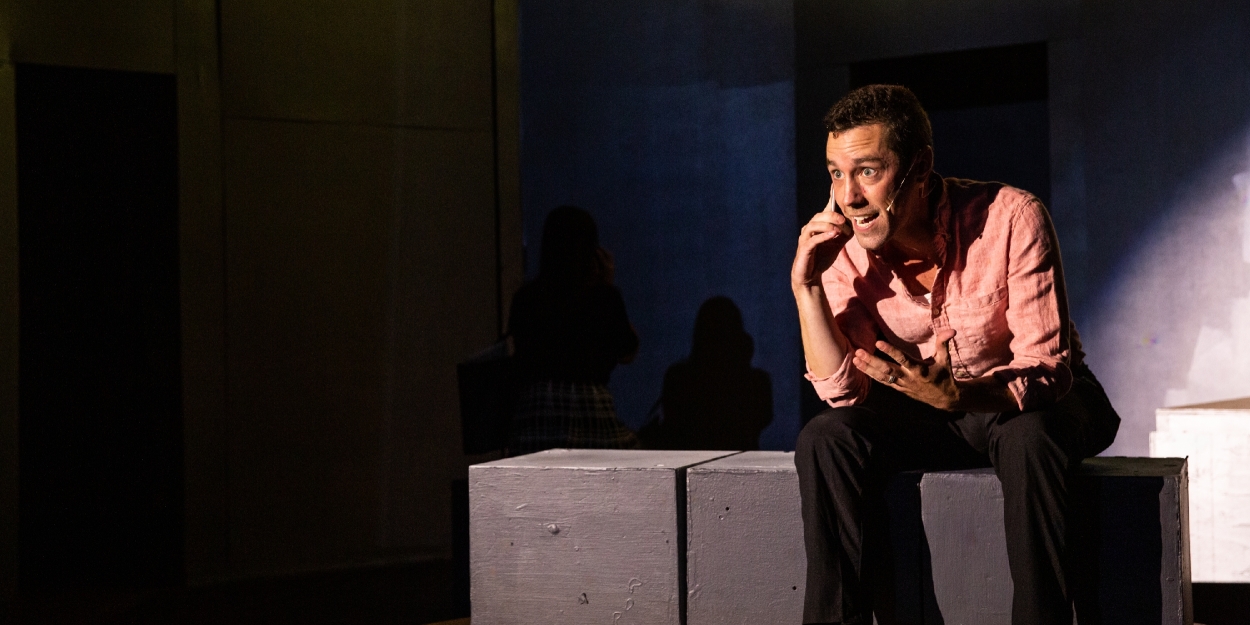
Desert Theatreworks (DTW) has done a fabulous job with its final presentation of the season, THE LAST FIVE YEARS, a one act, two-character, mostly sung-through musical by Jason Robert Brown, whose PARADE revival is currently playing on Broadway. Mr. Brown's take on the disintegration of a marriage, which unfolds before the audience's eyes and ears in eclectic musical styles, is emotionally powerful. The music, performed live by a keyboard and violin, and the superb on-stage performances in the production, help make this one of the most memorable shows I've seen.

From the first scene, we know that this couple will not live happily ever after - the wife, Cathy, is in their empty apartment getting ready to leave, and reading her husband's goodbye note. ("Still Hurting."). What we witness at the beginning sets the audience up for the searing storyline. However, what audience members may not realize going in - and the program notes do not explain - is that, what looks like a flashback with some hopping around between non-consecutive scenes is actually two separate timelines telling the same story, with one (Cathy's) in reverse chronological order.
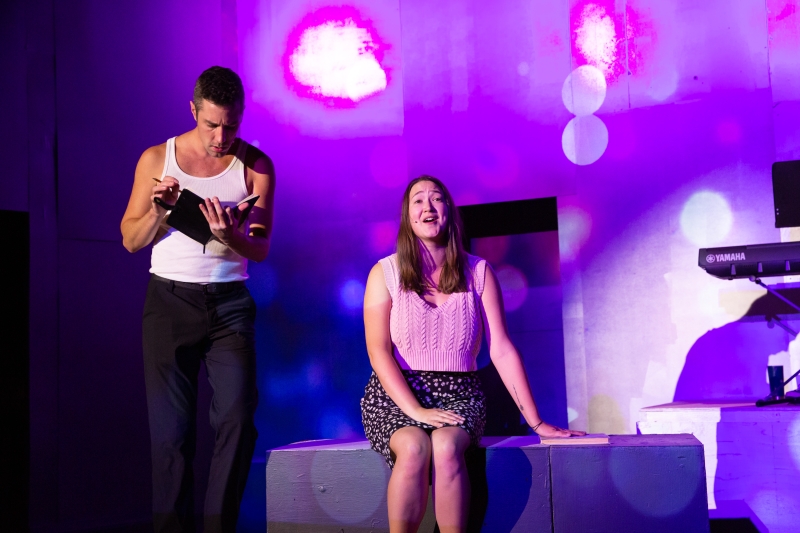
Jamie (John Corr), a successful author - a Jewish man who is poised on the cusp of fame just as he meets Cathy, his "Shiksa Goddess" - worries about his family's reaction to the non-Jewish Cathy (Tara Howard, alternating performances with Rachel Jewett). Cathy, an actor, is stuck in her career. One of the questions the play invites the audience to consider is whether Jamie is the total jerk that Cathy makes him out to be in the first song ("Still Hurting.") She points out that he cheated on her and says that he is completely focused on himself. While Jamie does indeed cheat, when exactly did he start? ("Nobody Needs to Know.") Is he self-centered? Perhaps. But he encourages Cathy to push forward with her career. ("If I Didn't Believe in You."). Or does he; that song takes place late in the musical. Is he talking to Cathy about how she can create the career she wants, or is he trying to push her out the door? This scene, among others, caused me to rethink Jamie's motives after discovering that the timelines move in opposite directions rather than hopscotching about. Without understanding the unusual sequencing, theatregoers are likely to miss, as I did, how the story unfolds.
The story starts in the present, where Cathy finds Jamie's goodbye note. We see Jamie, the husband, moving forward from meeting Cathy to getting married to the marriage's breakdown to his departure. Cathy's timeline, in contrast, moves backwards from her finding Jamie's good-bye note to the couple's meeting. Although this technique reminded me a bit of IF/THEN's alternate set of events, here the two timelines are the same story, which we see at different points during the five years, depending on whose point of view we are in at that moment. In effect, it is as if we're talking separately to the two spouses. One, Jamie, is telling the story of how they met, married, and saw their marriage disintegrate. Cathy starts with announcing the split and then explains how they got there, starting with the most recent events.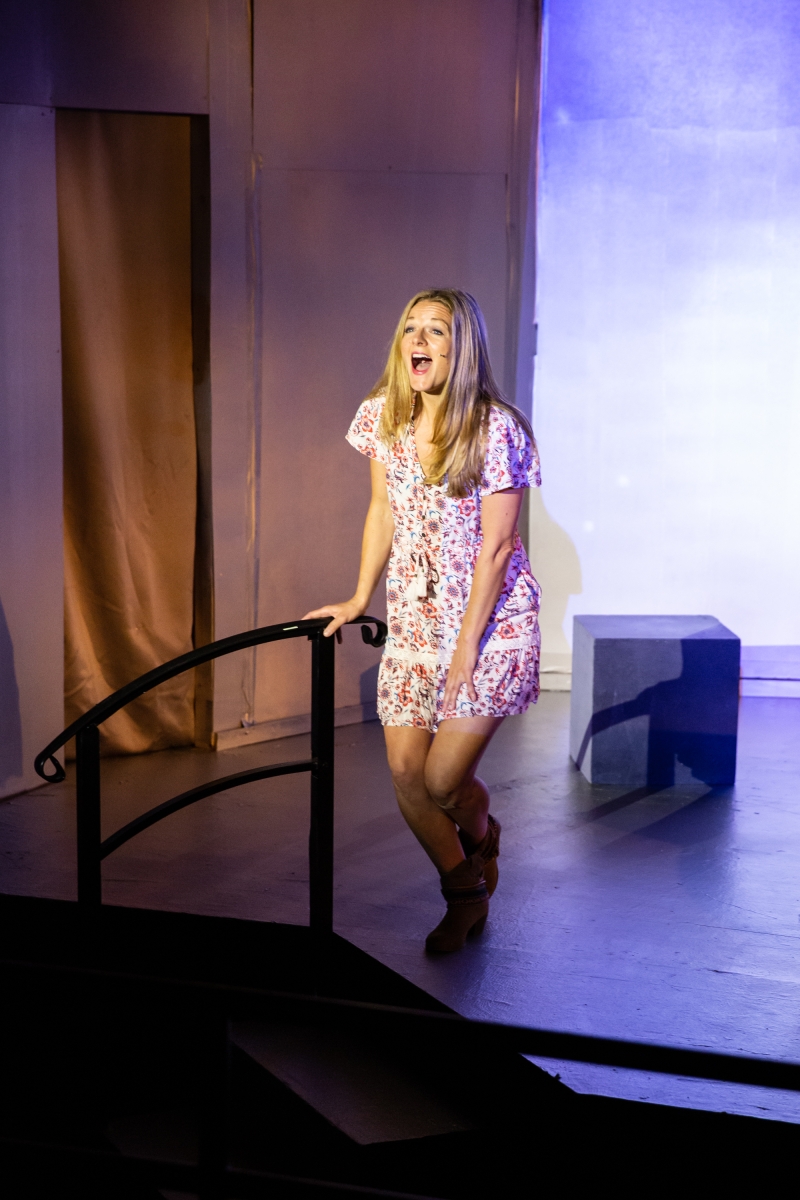
The two characters often share the stage without interacting - one of the most unusual aspects of the musical. We see them talk on the phone or write letters to each other, with the other partner unseen and unheard, except that the other individual is sometimes living out his or her present time a few feet away on the stage. Only once, when the timelines intersect, do the two actors (as opposed to the two characters) interact.
Director Daniela Ryan brilliantly gets the actors to unwrap the many onion layers in the script. At one point Jamie yells at his wife in a way that is so visceral that I can't imagine any actor remaining unaffected after delivering or receiving those lines. Ironically, although the writer and Mr. Corr give us a great deal of negative information about Jamie, I found it easier to empathize with his pain than with Cathy's. I think that is because he openly telegraphs how he is feeling, while Cathy seems to be more passive, or perhaps passive aggressive. Mr. Corr is a master at facial expressions, which helps Jamie telegraph every emotion. The fact that I feel so strongly about these characters is a testament to both Mr. Corr's and Ms. Howard's fine acting; these performers become their characters, rather than play them.
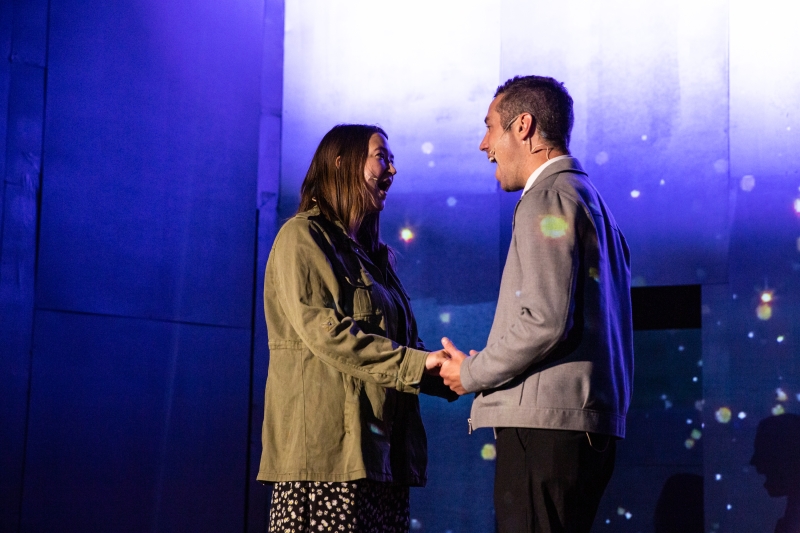 In a sung-through musical with only two performers - even a short one, such as this, which clocks in at 80 minutes - the singing has got to be extraordinarily taxing. This is especially true when much of the music consists of classical style arias. Mr. Corr has a lovely voice, but it is more folk than operatic. I noticed that he seemed a bit scratchy on the high tenor-range notes. He also has some unreasonably high falsetto passages that seemed to strain his voice. I blame the composer for including passages that are so high that they may well place male singers at risk. In contrast, Cathy's belting passages seem much more reasonable for a soprano to negotiate; Ms. Howard's agile voice seemed to handle both the belting and the operatic passages without difficulty. The live musical accompaniment (a keyboard, played by musical director Douglas Wilson, and a violin, played by Jeannine Manthey), rather than tracks, adds immeasurably to the vocal atmosphere.
In a sung-through musical with only two performers - even a short one, such as this, which clocks in at 80 minutes - the singing has got to be extraordinarily taxing. This is especially true when much of the music consists of classical style arias. Mr. Corr has a lovely voice, but it is more folk than operatic. I noticed that he seemed a bit scratchy on the high tenor-range notes. He also has some unreasonably high falsetto passages that seemed to strain his voice. I blame the composer for including passages that are so high that they may well place male singers at risk. In contrast, Cathy's belting passages seem much more reasonable for a soprano to negotiate; Ms. Howard's agile voice seemed to handle both the belting and the operatic passages without difficulty. The live musical accompaniment (a keyboard, played by musical director Douglas Wilson, and a violin, played by Jeannine Manthey), rather than tracks, adds immeasurably to the vocal atmosphere.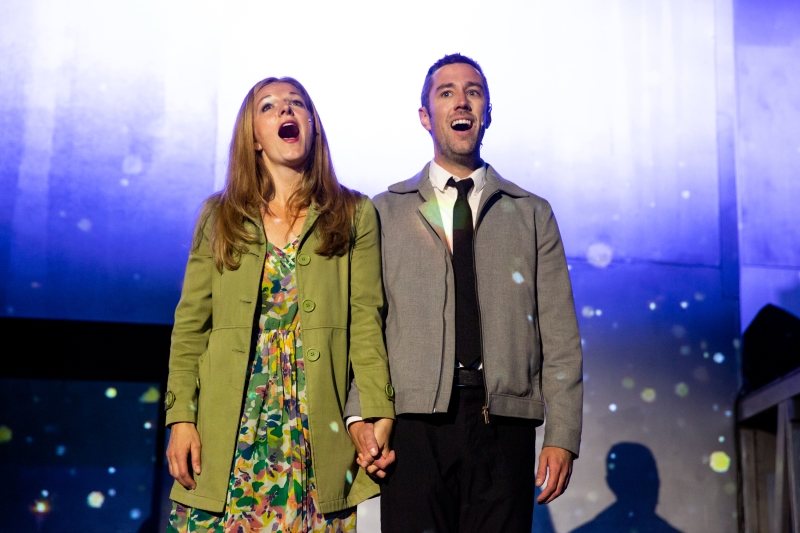
Despite or perhaps because the action takes place on a stage that is empty except for a few low-key box shapes that stand in for most of the furniture (Paul Mariani designed the spare set), the other technical aspects of the production are more important than usual. Duke Core designed the lighting (with Ethan Limas as the lightboard operator) and Miguel Arballo the sound (with Cecilia De La Torre operating the sound board). Director Daniela Ryan designed the costumes and Cecilia De La Torre served as stage and prop manager. They all did a fabulous job, but the technical star has to be Adriana Reyes, who designed the projections. The projections switch back and forth among videos, still photos, and abstract designs. There are numerous visuals regarding clocks, especially during "The Schmuel Song," which is about Jamie's story of a shtetl tailor who receives the gift of bending time for one night to allow him to sew a special dress for his beloved.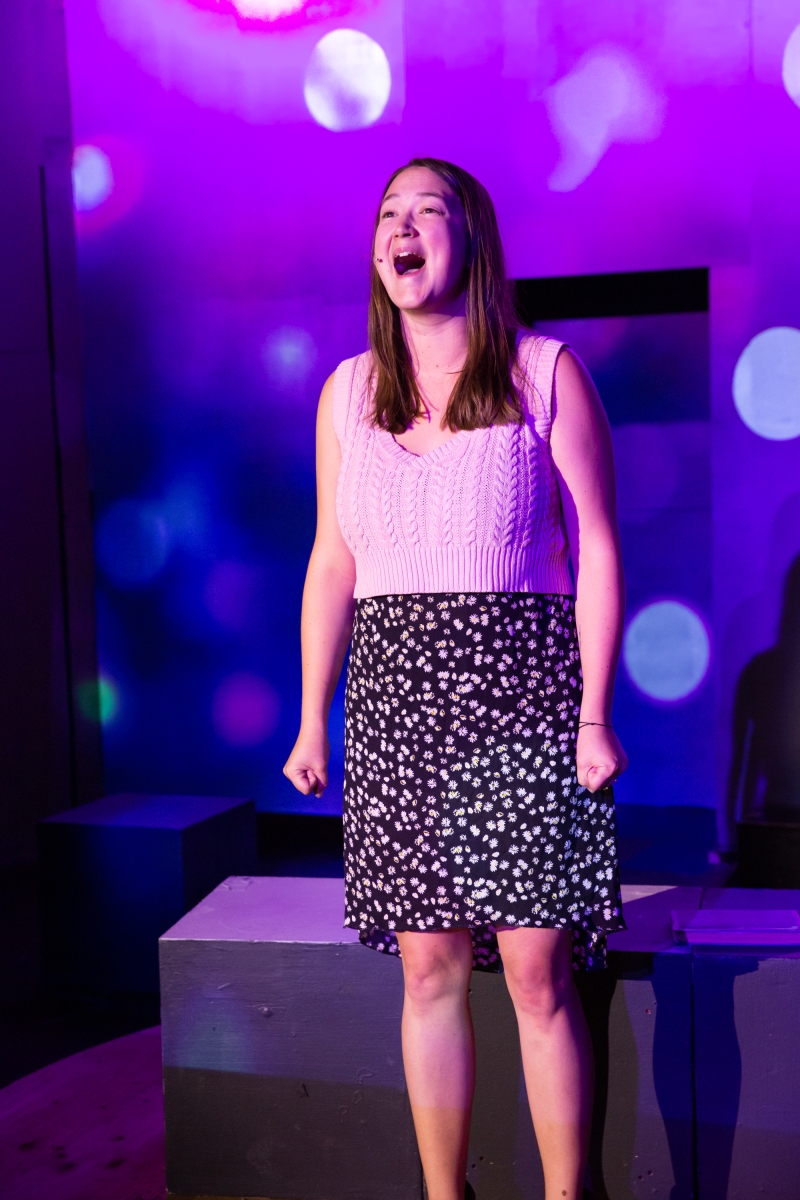
This excellent production is well worth seeing. I do, however, issue one caution: THE LAST FIVE YEARS is not an easy 80 minutes to sit through, but it is well worth the effort. Despite the high emotions, I am considering returning to see Rachel Jewett in the role of Cathy, both to see how her performance differs from Tara Howard's and how her performance affects John Corr's.
Besides, I really want another opportunity to examine the befores and afters.
THE NEXT FIVE YEARS will run through Sunday, May 21, 2023, with performances Fridays through Sundays. Rachel Jewett will appear as Cathy on May 12th, May 14th, and May 20th. Tara Howard will appear as Cathy on May 13th, May 19th, and May 21st. Performances begin at 7:30 p.m. on Fridays. Saturday and Sunday performances take place at 2:00 p.m. There will be an extra performance on Saturday May 20th, at 7:30 p.m. Check the ticket purchase information at www.dtworks.org for prices or call (760) 980-1455.
All performances take place at the Indio Performing Arts Center, 45175 Fargo Street, Indio, CA 92201. In partnership with C4 Communication, DTW will have ASL Interpreters at one of the Saturday, May 20th performances. However, the Web site does not specify which performance. I therefore recommend contacting the box office directly if you are interested in the ASL interpretation.
DTW has announced its seven productions for the 2023-24 season. Full and partial season packages are available. The offerings are:
Lend Me a Tenor
Kinky Boots
A Christmas Story
Gilligan's Island - the Musical
Neil Simon's Plaza Suite
Beautiful - the Carole King Musical
Harper Lee's To Kill a Mockingbird
PHOTO CREDIT: Tara Howard
Reader Reviews

Videos

